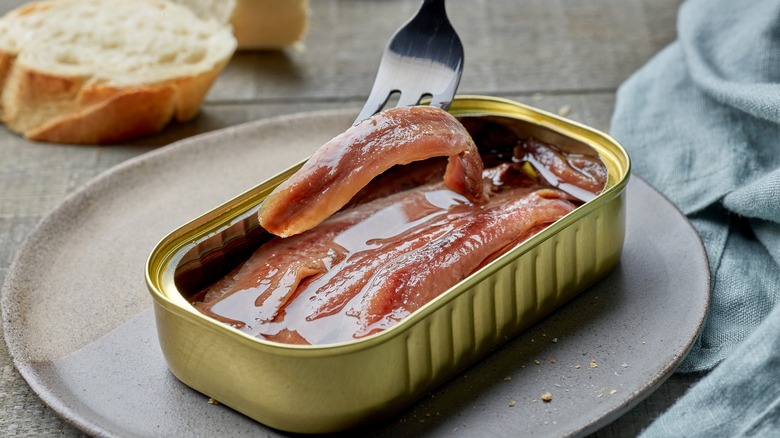Leftover Canned Anchovies? Make A Mouthwatering French Sauce
There's no denying that anchovies are a polarizing food. Some people are put off by the tiny fish and have never worked up the nerve to try them, while others are big fans.
Anchovies tend to be one of those peculiar, acquired-taste foods that you want nothing to do with until you suddenly like them. And when you do, you find yourself adding anchovies to your pizza and pasta, making anchovy butter, frying the little fish up to enjoy them on top of fresh bread, or adding them to a toasted baguette sandwich. The possibilities around this unexpected food suddenly become endless.
If you're one of those people who has finally come around to anchovies, you know that a little goes a long way. So, once you make your deliciously salty anchovy-studded meal, what do you do with the other 8-10 filets left in the can to save them from being buried in the fridge forever? We've got just the thing.
Anchovy lovers, meet anchoïade
Although it's technically a descendant of the Roman Empire's fermented fish sauce called garum, anchoïade hails from the Provence region in France and most likely originates in Nice. The first printed recipe appeared in Jean-Baptiste Reboul's "La cuisinière Provençale" in 1899. It's a salty, anchovy-forward signature sauce — sort of an anchovy paste meets vinaigrette — that allows the fish to shine while complementing their potency with a few other strong ingredients.
The beauty of this flavor-packed condiment is that you can use it however you want. Use it as a thick, pasty spread on crispy bread or sandwiches, a tangy salad dressing, or a dipping sauce for fresh or roasted vegetables. It makes for a great appetizer or picnic food, and as you can imagine, its salty fishiness pairs wonderfully with a cool glass of white wine.
As versatile as it is, it's equally as simple to create, and even better, you most likely already have most of the staples you need on hand. At its base, anchoïade only requires four ingredients: whole anchovies, olive oil, minced garlic, and an optional splash of vinegar. Red or white wine vinegar works great, but any acid will do the trick. Mix by hand or blend with a tool, and that's it — supremely simple, yet wildly flavorful.
Ways to mix up your anchoïade
Naturally, there are many recipe variations that substitute or add different ingredients to anchoïade for a slightly different effect. However, the ultimate goal is always to produce that signature briny, tangy condiment that speaks for itself.
As far as flavor tweaks, some recipes use fresh lemon juice or lemon zest for acidity instead of vinegar, and some include red pepper flakes for an extra punch. Other cooks throw in one or more of their favorite herbs – be it parsley, basil, or oregano – to freshen and brighten up the spreadable sauce. And some prefer to cook the mixture and serve it heated as a warm, savory dip.
If you want to change the texture a bit, add egg yolks or mustard to emulsify the anchoïade and make it creamier, creating a condiment that's more like a mayo or an aioli. Alternatively, you can add ingredients like olives, capers, or tomatoes to the mix — this will create more of a tapenade or bruschetta-like texture that's a bit heartier and can be enjoyed on top of some grilled bread.


